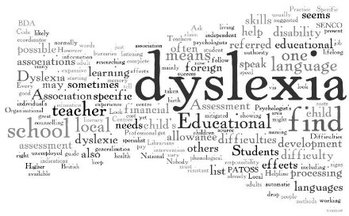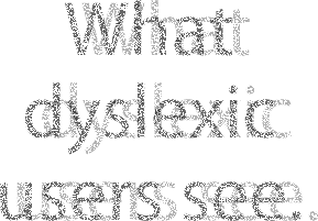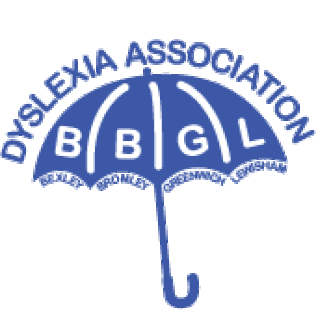DYSLEXIA
|
What is Dyslexia?
It is a specific learning difficulty which mainly affects the development of literacy and language related skills. Recent research has proved that dyslexia is certainly a difference in the way the brain works. Dyslexics have strengths in areas other than literacy. They may be exceedingly creative and artistic, excellent engineers and scientists or have great entrepreneurial skills (including the 'gift of the gab'). Dyslexia can have a substantial and long term adverse effect on normal day to day activities, and is therefore a recognised disability under the Equality Act 2010. |
A dyslexic child may have some of the following problems;
Reading and spelling.
Putting letters and figures the wrong way round / Difficulty remembering times tables and the alphabet.
Leaving letters out of words or putting them in the wrong order.
Confusing letters such as "b and d" or words such as "on and no".
Using their fingers to make simple calculations.
Poor concentration / Taking longer than average to complete their work.
Problems processing language at speed.
Tying shoe laces, ties, dressing etc / Difficulty telling left from right.
Poor organisational skills / Lacks confidence and has a poor self image.
It is important to establish if the child is following the "normal" age related problems or if there needs to be an assessment leading to a possible diagnosis being made. All children who have any problems, with or without a diagnosis will need support in their education. Dyslexia does not 'go away', but strategies can be successfully learnt to
overcome the problems it causes. If not helped, these children may not reach their full potential.
Information for helping Dyslexic children
- Allow plenty of time for homework in a stress free environment.
- Using coloured plastic wallets as overlays over a white page with black text, can help them with school work and reading. (Different colours work for children so try blue, green, red and yellow over different text to see what has the best effect. You can buy these in most stationary shops).
- Use coloured backgrounds and coloured paper wherever possible. Blue text on cream paper is popular.
- Coloured lenses can be used in your child's glasses although they are not free on the NHS.
- Use logos, pictures, listening books, audio tapes and visual aids.
- Local libraries often lend audio books to Dyslexic children for free.
- Change school timetables into coloured squares as Dyslexic children can associate that, for example, maths is always a green square. Match this with a green cover on any maths books and a green paper file at home for any maths paperwork/projects etc.
- Use a Dyslexic Friendly dictionary (the words are listed how they sound with the correct version next to them). Try PURRFIKT SPELLING by Christine Maxwell ISBN 978-1-84299-281-4.
- Try Dyslexic Friendly software for computers - the BDA can recommend approved suppliers.
- Join your local and national Dyslexia Associations (see our drop down sub menu for membership details).
- Use a search engine, the internet is full of advice, just make sure its from an approved/recognised website.
- An excellent website by a Dyslexic teenager is www.iamdyslexic.com.
- BT offer a free directory enquiry service for Dyslexics, for details call 195.
What should parents do if they feel their child is having problems at school?
Firstly always speak to your child's teacher to discuss any issues. A SENCO, Head Teacher or Head of Year may also become involved. They will help you and your child get the best support in their education. You can also contact Bexley's IASS who will be able to offer support and advice.
Here are helpful links from the British Dyslexia Association on education, reasonable adjustments and exam access arrangements:
https://www.bdadyslexia.org.uk/advice/children/my-childs-education/exam-access-arrangements
https://www.bdadyslexia.org.uk/advice/children/my-childs-education/reasonable-adjustments-in-education
https://www.bdadyslexia.org.uk/advice/children/my-childs-education/sen-support
Reading and spelling.
Putting letters and figures the wrong way round / Difficulty remembering times tables and the alphabet.
Leaving letters out of words or putting them in the wrong order.
Confusing letters such as "b and d" or words such as "on and no".
Using their fingers to make simple calculations.
Poor concentration / Taking longer than average to complete their work.
Problems processing language at speed.
Tying shoe laces, ties, dressing etc / Difficulty telling left from right.
Poor organisational skills / Lacks confidence and has a poor self image.
It is important to establish if the child is following the "normal" age related problems or if there needs to be an assessment leading to a possible diagnosis being made. All children who have any problems, with or without a diagnosis will need support in their education. Dyslexia does not 'go away', but strategies can be successfully learnt to
overcome the problems it causes. If not helped, these children may not reach their full potential.
Information for helping Dyslexic children
- Allow plenty of time for homework in a stress free environment.
- Using coloured plastic wallets as overlays over a white page with black text, can help them with school work and reading. (Different colours work for children so try blue, green, red and yellow over different text to see what has the best effect. You can buy these in most stationary shops).
- Use coloured backgrounds and coloured paper wherever possible. Blue text on cream paper is popular.
- Coloured lenses can be used in your child's glasses although they are not free on the NHS.
- Use logos, pictures, listening books, audio tapes and visual aids.
- Local libraries often lend audio books to Dyslexic children for free.
- Change school timetables into coloured squares as Dyslexic children can associate that, for example, maths is always a green square. Match this with a green cover on any maths books and a green paper file at home for any maths paperwork/projects etc.
- Use a Dyslexic Friendly dictionary (the words are listed how they sound with the correct version next to them). Try PURRFIKT SPELLING by Christine Maxwell ISBN 978-1-84299-281-4.
- Try Dyslexic Friendly software for computers - the BDA can recommend approved suppliers.
- Join your local and national Dyslexia Associations (see our drop down sub menu for membership details).
- Use a search engine, the internet is full of advice, just make sure its from an approved/recognised website.
- An excellent website by a Dyslexic teenager is www.iamdyslexic.com.
- BT offer a free directory enquiry service for Dyslexics, for details call 195.
What should parents do if they feel their child is having problems at school?
Firstly always speak to your child's teacher to discuss any issues. A SENCO, Head Teacher or Head of Year may also become involved. They will help you and your child get the best support in their education. You can also contact Bexley's IASS who will be able to offer support and advice.
Here are helpful links from the British Dyslexia Association on education, reasonable adjustments and exam access arrangements:
https://www.bdadyslexia.org.uk/advice/children/my-childs-education/exam-access-arrangements
https://www.bdadyslexia.org.uk/advice/children/my-childs-education/reasonable-adjustments-in-education
https://www.bdadyslexia.org.uk/advice/children/my-childs-education/sen-support
|
SCANNING PENS
Many companies sell scanning pens, a useful aid for anyone with a visual impairment including dyslexia. The scanning pen reads text out aloud or discretely through earphones, is a totally portable, pocket-sized device that reads text out aloud with an English human-like digital voice. Some pens are approved by the Joint Council for Qualifications (JCQ) for use in exams and is a major technological breakthrough. Bexley Voice suggest pens that have a clear voice sound, connects to headphones and has use of the Oxford English Dictionary. Bexley Voice is unable to endorse any company, however from feedback from our members, the C-Pen from Scanning Pens Ltd is a popular choice, although there are many types of pens available from various companies. We recommend you visit the British Dyslexia Association (details below) for more information about the use of scanning pens before considering a purchase. https://www.bdadyslexia.org.uk/fundraising/affinity-partners/scanning-pens Scanning Pens Ltd is one of the largest suppliers of mobile scanners in the world. This company provides assistive technology scanning pens suitable for home, education and exam use. Ideal for pupils with Dyslexia, Visual Impairment or any learning disability, including the C-Pen Reader Pen, C-Pen Exam Reader and C-Pen Dictionary Pen and supply to trade, schools and end users. www.scanningpens.co.uk |
|
LOCAL SUPPORT
Dyslexia Association of Bexley, Bromley, Greenwich and Lewisham. Dyslexia is now more widely recognised as a special need, thanks to the work and support by the Dyslexia Association of Bexley, Bromley, Greenwich and Lewisham. For dates of coffee mornings and open meetings, please visit the website. If you would like to become a member, please contact: Amanda Sutton, Dyslexia Association of Bromley Bexley Greenwich & Lewisham: Website: www.dyslexiawise.co.uk Email: [email protected] Tel No: 0300 999 1800 |
|
NATIONAL SUPPORT
The British Dyslexia Association (BDA) campaigns for a dyslexia friendly society where barriers to dyslexic people do not exist. The BDA works to ensure that ALL people with dyslexia fulfill their potential. To achieve this we need to create change, set standards and support and enable people. It is the voice of dyslexic people; it listens to their views, represents their agendas and presses for long lasting sustainable change. Website: www.bdadyslexia.org.uk Email: [email protected]. Tel No: 0845 251 9002 |
Source: BDA/DABBGL June 2014








